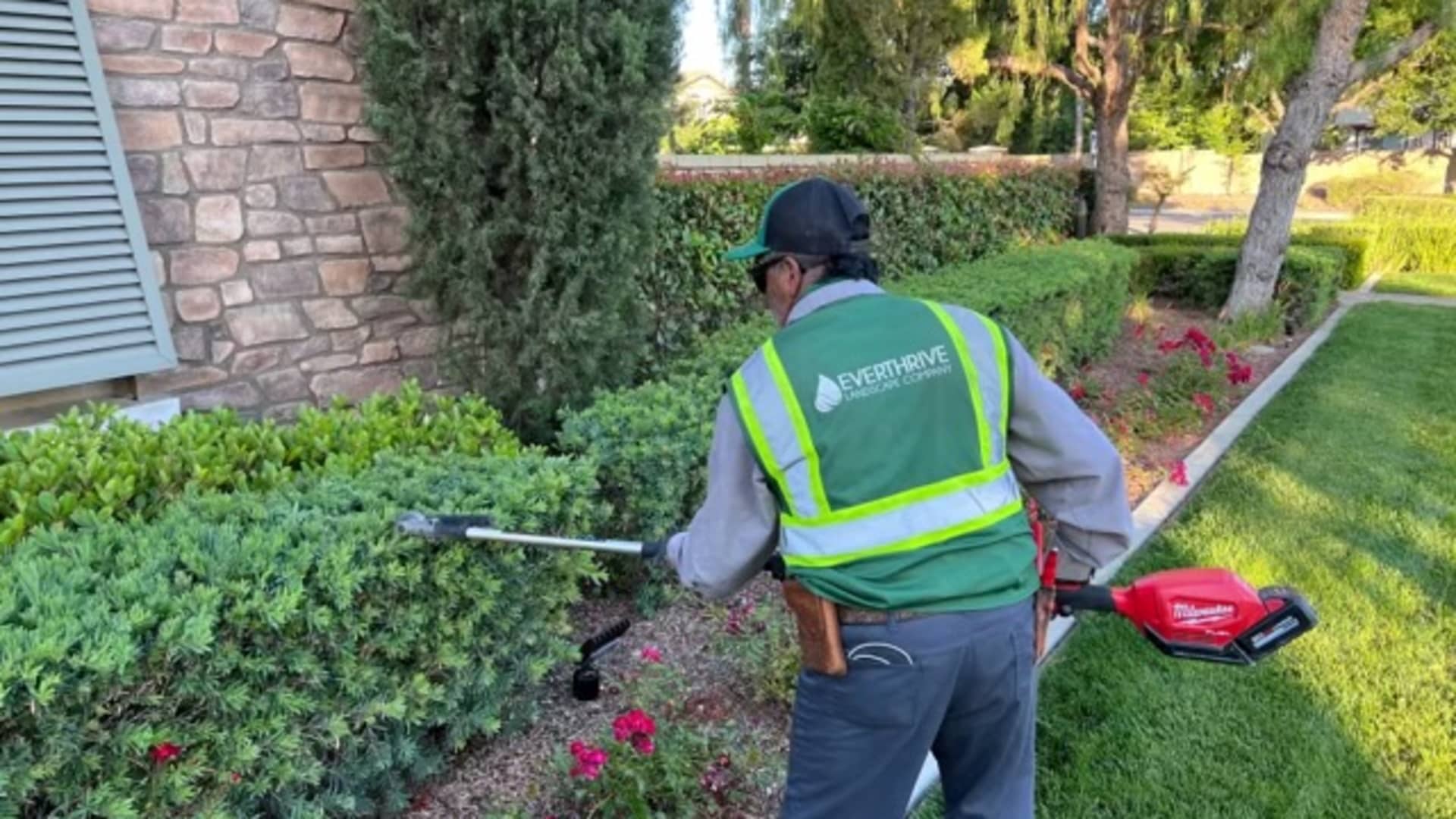
Some landscaping crews have begun to use battery-powered tools. California-based Everthrive Landscape is one of the companies that’s switched to the equipment.
Courtesy of Everthrive Landscape
The auto industry isn’t the only one going electric.
In Home Depot and Lowe’s, one of the buzziest aisles features battery-powered leaf blowers, mowers, string trimmers and more. Those electric-powered outdoor tools have started to take hold in neighborhoods and at golf courses around the country.
The transition away from gas power could come at a good time for the two home improvement retailers. Both have looked for a jolt as they see weaker store traffic and brace for declining sales in the year ahead. Home Depot posted its worst revenue miss in 20 years for the fiscal first quarter and lowered its full-year forecast, saying it expects sales to decline by between 2% and 5% this fiscal year. Lowe’s also cut its outlook and projected a drop in sales for the full year.
Outdoor power equipment drives just a small fraction of the retailers’ sales, said Zack Fadem, an analyst at Wells Fargo. But, he added, advancements in battery-powered tools have prompted an upgrade cycle and given do-it-yourself customers and home professionals a reason to come to stores for bigger purchases.
“When you ask ‘What’s been driving the ticket,’ aside from inflation and like-for-like increases in product costs, the biggest driver is innovation,” he said. “And that’s where these new products fit in.”
He said investors will watch whether battery-powered tools, and other new products across stores like higher-quality paint, flooring and appliances, can truly be a “needle mover.”
As the easy sales gains of the Covid pandemic fade, both Home Depot and Lowe’s have pointed to the cordless, battery-powered tools as an opportunity. Home Depot touted the products at an investor day in New York City earlier this month, and it recently set a goal to have more than 85% of its U.S. and Canada sales in outdoor power equipment run on rechargeable batteries instead of gas by late January 2029. It declined to say where the share of sales is today.
Home Depot estimated that the market for electric tools and related battery sales is $32 billion and counting.
Industrywide, battery-powered cordless units accounted for nearly 66% of sales in the outdoor power tools market as of the end of 2022, according to an economic forecast report from the Outdoor Power Equipment Institute.
Lowe’s said battery-powered tools and outdoor equipment are among its fastest-growing categories. Bill Boltz, the company’s executive vice president of merchandising, said Lowe’s sales of cordless power tools and outdoor power equipment more than doubled in the past five years — a rapid clip that the company expects will continue in the next five years.
There are still obstacles to adoption. Battery-powered leaf blowers and mowers can be similar in price to their gas competitors. But when you add in batteries and chargers, upfront charges can be higher.
One of the buzziest aisles in Home Depot is the one with battery-powered outdoor equipment like mowers and leaf blowers. Lowe’s also has seen sales growth in the category.
Melissa Repko | CNBC
A jolt in interest
For more than two decades, manufacturers have offered battery-powered tools. The first electric outdoor equipment hit Home Depot and Lowe’s shelves in the mid-2000s.
Yet several more recent factors have increased interest in electric power for landscaping. Technology has improved, bringing longer-lasting batteries and more power, without the mess or expense of gas. Some states and cities have proposed or passed limits on gas-powered equipment or offered rebates and tax credits for battery-powered tools.
The tools, while much smaller than a car, can contribute to a lot of smog-forming emissions. Operating a commercial lawn mower for one hour emits as much pollution as driving a new light-duty passenger car the more than four-hour journey from Los Angeles to Las Vegas, according to the California Air Resources Board, a state government agency.
Plus, the spike in working from home means more Americans have noticed the irritating growl of a gas-powered leaf blower outside of their window, prompting some to buy quieter battery-powered tools for their own yard or lobby the homeowner’s association for a ban.
California, the most populous state in the country, is also sparking change. It passed a law that bans the sale of emissions-producing small, off-road engines like the ones in mowers and blowers starting in 2024.
With or without policy changes, do-it-yourself customers have been quick to embrace battery power, said Billy Bastek, Home Depot’s executive vice president of merchandising.
Now, he said the company wants to win over professionals, who tend to place bigger orders and replace equipment more frequently. Home Depot is offering dedicated support, special pricing for large orders and rewards through its pro loyalty program.
About half of Home Depot’s total sales come from home professionals, but electric tool revenue skews toward DIY buyers. The company declined to share a more specific split for the battery-powered category.
As the upgrade cycle takes hold at Home Depot and Lowe’s, the equipment makers themselves stand to benefit. Those include a variety of companies that have expanded their battery and hybrid lineup, such as John Deere, Toro, Stanley Black & Decker-owned DeWalt, Ryobi and others.
Some of them have exclusive deals with the home improvement retailers. For example, Home Depot is the only retailer that sells Milwaukee and Ryobi.
Not all retailers see the tools as a significant sales catalyst.
Tractor Supply, a home improvement player that tends to be in rural areas, has been slower to add battery-powered outdoor equipment. It introduced the merchandise to stores and online early last year, after waiting to see a pickup in both customer interest and battery strength, said company spokeswoman Mary Winn Pilkington.
She said it’s been only a modest growth category for the retailer, which often caters to ranchers, farmers or homeowners with larger properties.
Some prominent golf courses have begun to test and use electric-powered landscaping equipment. At TPC Sawgrass in Florida, the landscaping crew has tried out an autonomous battery-powered mower and uses some electric leaf blowers.
Jeff Plotts
From golf courses to suburban neighborhoods
On the expansive TPC Sawgrass golf course in Ponte Vedra Beach, Florida, the landscaping crew has tested a new assistant: an autonomous electric mower.
The course is home to The Players Championship, one of the most prominent annual golf tournaments on the PGA Tour. It relies on an approximately 105-person staff to maintain 450 total acres, of which 240 are maintained turf grass.
Jeff Plotts, the course’s director of agronomy, began trying out the Husqvarna device to cut grass on nearly an acre of turf in January.
So far, Plotts said he’s been impressed by its performance. It’s been a quieter way to keep up turf, a help as the course competes in a tight labor market — and an occasional source of fascination for golfers.
“It’s extremely quiet. You could be standing right next to it and you can’t tell, other than seeing it move, it’s cutting,” he said. “It’s a pretty slick little unit.”
He said the course plans to buy 15 more of the mowers in 2024.
About 150 miles southwest, the landscaping crew at Bay Hill Club and Lodge of Orlando — the host of the PGA Tour’s Arnold Palmer Invitational — uses a small number of electric blowers, said Chris Flynn, director of grounds. It also has an electric weed eater, hedge trimmer and walk-behind push mower.
Both Plotts and Flynn say it would be difficult, if not impossible, to make a full switch away from gas-powered equipment — at least with the technology available now. On some days, it can still be quicker to use gas-powered tools. The specialized products needed to maintain courses sometimes do not come in electric models.
Upfront costs can also be a deterrent. Flynn said that in a recent estimate, a riding electric-power mower for the golf course would have cost $94,000, compared with a gas-powered one for $43,000.
“Just like a the automotive market all of the equipment manufacturers are obviously spending a lot of R&D [research and development] on electric and hybrid options,” Flynn said. “As time goes forward, there are a going to be a lot more options. And like anything, you hope the longer it’s around it brings costs down.”
In suburban neighborhoods far from the hush of professional golf tournaments in Florida, homeowners and property managers are also embracing a quieter way to keep up their yards.
Southern California-based Everthrive Landscape began looking into electric equipment in late 2021, shortly after California passed a law aimed at winding down use of gas equipment.
It started the transition to electric power in February and recently placed a large order with Milwaukee that will take its fleet up to about 80% electric in the coming months.
The commercial landscaping company specializes in maintaining the properties of homeowners associations, such as landscaping around parks, pools or clubhouses.
The company’s CEO, Jonathan Caceres, said the tools have been popular among customers and employees. Employees don’t have to worry about noxious fumes and blaring noise. And they don’t get the same complaints from homeowners or apartment residents who are sleeping or in the middle of a Zoom call.
But Caceres said he had to get his crew to buy in. Some had been disappointed by battery equipment they tested years ago, which was cumbersome and didn’t do the job.
He said the electric tools were the right choice not only for the environment, but also for the bottom line. No more gas runs take the crew away from jobs. Warrantees on the equipment also last longer.
He said other businesses will likely be persuaded by that, too.
“It all comes down to money,” he said. “If they see ‘Oh wow, this is going to save me money,’ that will be a big driver.”







